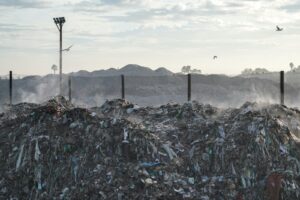‘Plastic-free’ fashion is not as clean or green as it seems
Thomas Stanton and Kieran Phelan from the University of Nottingham discuss the growing trend towards sustainable fashion, explaining why it is not always as black and white as it may first seem.
We have all become more aware of the environmental impact of our clothing choices. The fashion industry has seen a rise in ‘green’, ‘eco’ and ‘sustainable’ clothing. This includes an increase in the use of natural fibres, such as wool, hemp, and cotton, as synthetic fabrics, like polyester, acrylic and nylon, have been vilified by some.
However, the push to go ‘natural’ obscures a more complex picture.
Natural fibres in fashion garments are products of multiple transformation processes, most of which are reliant on intensive manufacturing as well as advanced chemical manipulation.
While they are presumed to biodegrade, the extent to which they do has been contested by a handful of studies. Natural fibres can be preserved over centuries and even millennia in certain environments. Where fibres are found to degrade they may release chemicals, for example from dyes, into the environment.
When they have been found in environmental samples, natural textile fibres are often present in comparable concentrations than their plastic alternatives. Yet, very little is known of their environmental impact.
Therefore, until they do biodegrade, natural fibres will present the same physical threat as plastic fibres. And, unlike plastic fibres, the interactions between natural fibres and common chemical pollutants and pathogens are not fully understood.
Fashion’s environmental footprint
It is within this scientific context that fashion’s marketing of alternative fibre use is problematic. However well-intentioned, moves to find alternatives to plastic fibres pose real risks of exacerbating the unknown environmental impacts of non-plastic particles.
To assert that all these problems can be resolved by buying ‘natural’ simplifies the environmental crisis we face.
To promote different fibre use without fully understanding its environmental ramifications suggests a disingenuous engagement with environmental action. It incites ‘superficial green’ purchasing that exploits a culture of plastic anxiety. Their message is clear: buy differently, buy ‘better’, but don’t stop buying.
Yet the ‘better’ and ‘alternative’ fashion products are not without complex social and environmental injustices. Cotton, for example, is widely grown in countries with little legislation protecting the environment and human health.
The drying up of the Aral Sea in central Asia, formally the fourth largest lake in the world, is associated with the irrigation of cotton fields that dry up the rivers that feed it.
This has decimated biodiversity and devastated the region’s fishing industry. The processing of natural fibres into garments is also a major source of chemical pollution, where factory wastewaters are discharged into freshwater systems, often with little or no treatment.
Organic cotton and Woolmark wool are perhaps the most well known natural fabrics being used.
Their certified fibres represent a welcomed material change, introducing to the marketplace new fibres that have codified, improved production standards. However, they still contribute fibrous particles into the environment over their lifetime.
More generally, fashion’s systemic low pay, deadly working conditions, and extreme environmental degradation demonstrate that too often our affordable fashion purchases come at a higher price to somebody and somewhere.
Slow down fast fashion
It is clear then that a radical change to our purchasing habits is required to address fashion’s environmental crisis. A crisis that is not defined by plastic pollution alone.
We must reassess and change our attitudes towards our clothing and reform the whole lifecycle of our garments. This means making differently, buying less and buying second hand. It also means owning for longer, repurposing, remaking and mending.
Fashion’s role in the plastic pollution problem has contributed to emotive headlines, in which purchasing plastic-fibred clothing has become highly moralised.
In buying plastic-fibred garments, consumers are framed complicit in poisoning the oceans and food supply. These limited discourses shift accountability onto the consumer to ‘buy natural’. However, they do little to equally challenge the environmental and social ills of these natural fibres and the retailers’ responsibilities to them.
The increased availability of these ‘natural’ fashion products, therefore, fails to fundamentally challenge the industry’s most polluting logic – fast, continual consumption and speedy routine discard. This only entrenches a purchasable, commodified form of environmental action – ‘buying natural’. It stops the more fundamental reassessment of fast fashion’s ‘business as usual,’ that we must slow.
This article is republished from The Conversation under a Creative Commons license. Read the original article here.
Photo Credit – Pixabay















